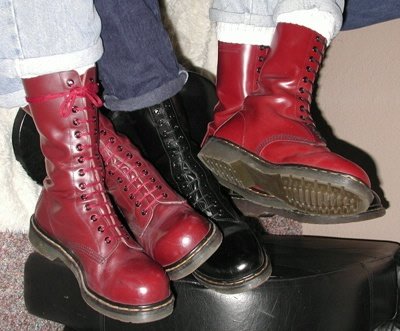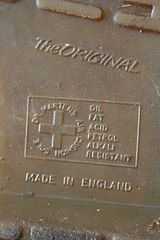British Heritage
Remember, Cherish, Learn.
beta
Dr. Martens - AirWair
A Cornerstone of British Heritage.
Few brand names encapsulate the rich, diverse heritage of the United Kingdom as Dr. Martens does. Known colloquially as Docs or DMs, Dr. Martens is a symbol of British counterculture, an ambassador of British style, and a ubiquitous part of the country's social fabric. Its impact stretches far beyond its roots in Northamptonshire, with its iconic boots and shoes resonating with generations across the globe.
The journey of Dr. Martens begins with the practical needs of a German army doctor, Klaus Märtens. After suffering a foot injury in World War II, he sought comfort that his standard-issue army boots failed to deliver. With soft leather and air-cushioned soles ingeniously crafted from discarded tyres, Märtens designed a boot that was both comfortable and durable.
After the war, Märtens partnered with his old university friend, Herbert Funck. Intrigued by Märtens' novel shoe design, Funck became instrumental in establishing their footwear business in Seeshaupt, Germany, in 1947. Their boots, characterized by comfortable, mould-shaped rubber soles, quickly became popular, especially among women over the age of 40.
In 1959, the success of their venture led Märtens and Funck to consider international markets. The British shoe manufacturer R. Griggs Group Ltd. seized the opportunity, acquiring the patent rights to produce the shoes in the UK. Griggs anglicised the name to "Dr. Martens", re-shaped the heel for better fit, added the now trademark yellow stitching, and coined the term 'AirWair' for the unique soles.
The first British-made Dr. Martens boots, an eight-eyelet, cherry red design known as style 1460, were introduced on April 1, 1960. These boots were made in the Cobbs Lane factory in Wollaston, Northamptonshire. This style is still in production today, demonstrating the enduring appeal of Dr. Martens' design.
Dr. Martens boots and shoes became popular across a broad spectrum of society. Workers, including postmen, police officers, and factory employees, favored the sturdy, comfortable footwear. They soon became a fashion staple for various youth subcultures, from skinheads in the late 1960s to punks and new wave musicians in the late 1970s. Despite some negative associations with violence due to their popularity among politically right-wing skinheads, the brand's status continued to grow.
The 1980s and 1990s saw the brand spreading its influence globally. In 1989, Accent Group became the first manufacturer of Dr. Martens outside the UK, obtaining rights to produce them in Dunedin, New Zealand. The boots and shoes were embraced by the emerging grunge fashion scene in the 1990s, demonstrating their adaptability to changing trends.
By the late 1990s, Dr. Martens had also begun to establish a presence in sports sponsorship. They supported Rushden & Diamonds F.C. from 1998 to 2005, leading to the construction of the 'AirWair Stand' at Nene Park. They were also the principal sponsors of Premier League club, West Ham United F.C., resulting in the renaming of the west stand as 'The Dr. Martens Stand'.
Despite some legal disputes and lawsuits in the late 90s and early 2000s, the brand continued to innovate and adapt. In the early 2000s, they launched the AirWair line, offering dozens of styles, including conventional black shoes, sandals, and steel-toed boots.
Dr. Martens' journey has not been without challenges. The brand experienced a severe downturn in the early 2000s, with revenue falling from US$412 million in 1999 to $127 million in 2006. The company also had to move its production to China and Thailand in 2003 due to declining sales, resulting in the closure of its UK factories and job losses for more than 1,000 employees.
With the introduction of a new range of shoes and boots in 2004, designed to be more comfortable and appealing to a younger market, Dr. Martens began to turn its fortunes around. In 2005, under the leadership of turnaround CEO David Suddens, the company received an award from the Institute for Turnaround for successfully implementing a restructuring plan.
Sales of Dr. Martens shoes grew rapidly in the early 2010s, making it the eighth-fastest-growing British company in 2012. By 2010, the company had sold over 100 million pairs of shoes and offered 250 different models of footwear.
In 2013, the private equity company Permira acquired R. Griggs Group Limited, the owner of the Dr. Martens brand, for £300 million. The brand has seen steady growth since the acquisition, with annual revenue in 2019 reaching £454 million, six times more than in 2013.
Although the company faced criticisms about quality following the move to Asian production, it has worked to address these concerns, claiming no significant change in materials or production processes. Dr. Martens continues to expand, with plans to double the production of shoes and boots in the UK to 165,000 pairs annually in 2020.
In 2021, Dr. Martens was listed on the London Stock Exchange, valued at £3.7 billion, cementing its status as a British icon.
Dr. Martens has left an indelible mark on British heritage. It is not just a shoe, but a symbol of rebellion, self-expression, and endurance. The brand's trajectory tells a story of resilience, innovation, and adaptation. From the factory floors of Northamptonshire to the bustling streets of Camden Town, Dr. Martens has become an integral part of British cultural identity, defining and being defined by the diverse people who wear them. The yellow stitches and air-cushioned soles are not just design features, but icons of a legacy that continues to bounce ahead.
Founding and Design Origins
The journey of Dr. Martens begins with the practical needs of a German army doctor, Klaus Märtens. After suffering a foot injury in World War II, he sought comfort that his standard-issue army boots failed to deliver. With soft leather and air-cushioned soles ingeniously crafted from discarded tyres, Märtens designed a boot that was both comfortable and durable.
After the war, Märtens partnered with his old university friend, Herbert Funck. Intrigued by Märtens' novel shoe design, Funck became instrumental in establishing their footwear business in Seeshaupt, Germany, in 1947. Their boots, characterized by comfortable, mould-shaped rubber soles, quickly became popular, especially among women over the age of 40.
The British Legacy
In 1959, the success of their venture led Märtens and Funck to consider international markets. The British shoe manufacturer R. Griggs Group Ltd. seized the opportunity, acquiring the patent rights to produce the shoes in the UK. Griggs anglicised the name to "Dr. Martens", re-shaped the heel for better fit, added the now trademark yellow stitching, and coined the term 'AirWair' for the unique soles.
The first British-made Dr. Martens boots, an eight-eyelet, cherry red design known as style 1460, were introduced on April 1, 1960. These boots were made in the Cobbs Lane factory in Wollaston, Northamptonshire. This style is still in production today, demonstrating the enduring appeal of Dr. Martens' design.
Dr. Martens boots and shoes became popular across a broad spectrum of society. Workers, including postmen, police officers, and factory employees, favored the sturdy, comfortable footwear. They soon became a fashion staple for various youth subcultures, from skinheads in the late 1960s to punks and new wave musicians in the late 1970s. Despite some negative associations with violence due to their popularity among politically right-wing skinheads, the brand's status continued to grow.
International Success and Expansion
The 1980s and 1990s saw the brand spreading its influence globally. In 1989, Accent Group became the first manufacturer of Dr. Martens outside the UK, obtaining rights to produce them in Dunedin, New Zealand. The boots and shoes were embraced by the emerging grunge fashion scene in the 1990s, demonstrating their adaptability to changing trends.
By the late 1990s, Dr. Martens had also begun to establish a presence in sports sponsorship. They supported Rushden & Diamonds F.C. from 1998 to 2005, leading to the construction of the 'AirWair Stand' at Nene Park. They were also the principal sponsors of Premier League club, West Ham United F.C., resulting in the renaming of the west stand as 'The Dr. Martens Stand'.
Despite some legal disputes and lawsuits in the late 90s and early 2000s, the brand continued to innovate and adapt. In the early 2000s, they launched the AirWair line, offering dozens of styles, including conventional black shoes, sandals, and steel-toed boots.
Dr. Martens' journey has not been without challenges. The brand experienced a severe downturn in the early 2000s, with revenue falling from US$412 million in 1999 to $127 million in 2006. The company also had to move its production to China and Thailand in 2003 due to declining sales, resulting in the closure of its UK factories and job losses for more than 1,000 employees.
Renaissance and Modern Times
With the introduction of a new range of shoes and boots in 2004, designed to be more comfortable and appealing to a younger market, Dr. Martens began to turn its fortunes around. In 2005, under the leadership of turnaround CEO David Suddens, the company received an award from the Institute for Turnaround for successfully implementing a restructuring plan.
Sales of Dr. Martens shoes grew rapidly in the early 2010s, making it the eighth-fastest-growing British company in 2012. By 2010, the company had sold over 100 million pairs of shoes and offered 250 different models of footwear.
In 2013, the private equity company Permira acquired R. Griggs Group Limited, the owner of the Dr. Martens brand, for £300 million. The brand has seen steady growth since the acquisition, with annual revenue in 2019 reaching £454 million, six times more than in 2013.
Although the company faced criticisms about quality following the move to Asian production, it has worked to address these concerns, claiming no significant change in materials or production processes. Dr. Martens continues to expand, with plans to double the production of shoes and boots in the UK to 165,000 pairs annually in 2020.
In 2021, Dr. Martens was listed on the London Stock Exchange, valued at £3.7 billion, cementing its status as a British icon.
Dr. Martens: More Than a Shoe
Dr. Martens has left an indelible mark on British heritage. It is not just a shoe, but a symbol of rebellion, self-expression, and endurance. The brand's trajectory tells a story of resilience, innovation, and adaptation. From the factory floors of Northamptonshire to the bustling streets of Camden Town, Dr. Martens has become an integral part of British cultural identity, defining and being defined by the diverse people who wear them. The yellow stitches and air-cushioned soles are not just design features, but icons of a legacy that continues to bounce ahead.
- Dr. Martensen.wikipedia.org

















